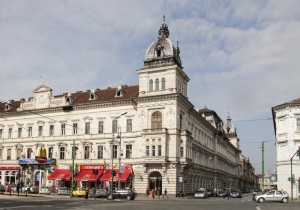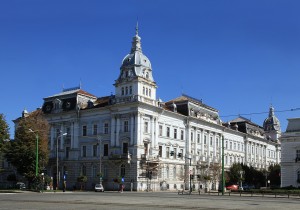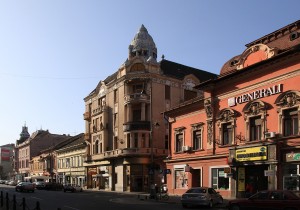The palace of Szántay Lajos, an architect native of Arad, famous in Europe, is a brilliant epitome of Secession architecture, its grandeur highlighted by structural and decorative details alike. Szántay Lajos (1872- 1961) was one of the most valuable architects of Arad, acknowledged internationally.
History
The architect Ludovic Szántay, born in Arad on February 20, 1872, based his success on a series of Secession buildings he projected. Thanks to his work of a life, the Secession visual language is an important part of the architectural image of Arad. Ludovic Szántay is the most often encountered architect in Arad, due to the multitude of buildings he designed throughout his life.
The Szántay Palace remains one of the main buildings typical of the Secession style practiced in Arad. This stylistic reference can be found in: the specific joinery preserved, the decorative components of wrought iron and sheet metal works, and last but not least, the plaster decorations, with vegetal and geometrical elements, with masks and volute, which graces the surfaces of the walls.
This building is perfectly integrated whithin the category of contemporary Palaces, as it sure is one of the most representative examples of this genre. The construction of this splendid building took place during 1905-1911, Szántay Palace being the residence of the architect himself.
Even though he gave the community a multitude of unprecedented buildings, thereby marking a definite print of the Secession stylistic in the urban area of Arad, during the communist regime, for almost 15 years Ludovic Szántay endured extreme poverty and repeated humiliations from the local authorities. After a lifetime devoted to creating buildings that gave the town a certain nobility, the architect finally dies of cold in the attic of his own house, in the glorious Palace of Szántay. History tells us that he was found deceased on 8 March, 1961, and also that towards the end of his life, the giant of european architecture had to burn its own projects and drawings in order to warm himself up during the winter.
Architecture
The imposing Palace of architect Ludovic Szántay was constructed in 1905 - a two-storey building housing luxurious apartments, which nowadays also shelters shops and workshop. The Palace is an array of Arad’s Secession architecture, dominated by a tower that supports the Earth.
The edifice marvels through the accuracy of plaster, its metallic ornaments, pedestrian gates, balconies, as well as through the elegance of the sculptures supporting the balconies of the second floor. The floral stained glass windows, along with the wrought iron staircase that rises from the ground floor to the top one, are also unique. The “Bow-windows”, situated just under the roof, reinforce the Secession appearance of the building.
Interesting facts
Ludovic Szántay was considered a driving force of monumental architecture, elegantly proportioned, which recalls the grandeur of imperial ages. Ludovic Szántay will remain one of the most famous architects of Arad. Among his most famous and impressive works in Arad are: Palace of Culture, the Lutheran Church, Palace Station, Cenad Palace, Szántay Palace, Bohuș Palace, the Palace of Kohn, Lloyd Palace etc. Ludovic Szántay has attained his greatest professional success in the first two decades of the 20th century.
History reminds us that Ludovic Szántay along with Emil Tabacovici, against whom he was artistically and professionally competing, have completed the architectural vocabulary of Arad, in the early part of the 20th century. Other well-known architects of Arad were: Josef Steiner, Lajos Kövér, Tibor and Mary Fanny Köver, Joszef Szabo, Sándor and László Dömötör Reisinger and Miloș Cristea.
Similar tourist attractions
Neumann Palace, built in the past as a private residence with a special architecture, accommodates today commercial spaces and spaces of „Vasile Goldiș” Western University of Arad.
The building was built between 1892-1894 by Arad-Cenad Railway Company. The plans were made in the workshop of architect Miklós Ybl in Budapest and subsequently adapted by Lajos Jiraszek.
This outstanding building in the heart of Arad belonged to baron Bohuș. The Palace is the work of local architect Ludovic Szántay and was inaugurated in 1913.





